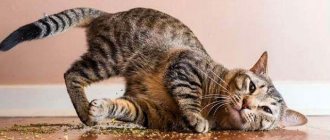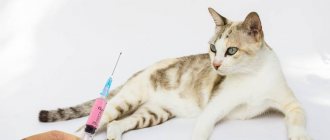- home
- Cats
- What is the benefit to humans from the purring of cats?
Cat owners will confirm that there is nothing better than cuddling with your pet, stroking it behind the ears and listening to a contented purr. But this cute sound not only shows us that the cat is happy, but can also bring real benefits to humans.
Important! Cats purr at a specific frequency that is believed to have healing benefits for humans - from heart health to strong, strong bones.
Purring is a way for fluffies to communicate, through which they show us the full range of their emotions. Depending on the breed, cats may purr in different ways. But, basically, the range of their purring is 18-20 Hz. So, how is it good for human health?
Benefit #1: Reduces Stress Levels
The feeling of satisfaction and relaxation when your beloved furry is nestled on your chest or lap is by no means a placebo effect. The frequency of a cat's purr falls into a very "therapeutic" sound range that relaxes the nerves and makes you feel more comfortable.
So the next time you're feeling stressed, try sitting down with your cat on the couch and see if its vibrations are working for you.
A reason to purr
Cats do not always purr, but only in special cases:
– after games and communication with the owner, when the animal is about to rest; – the mother cat demonstrates to the kittens that they are safe and need not be afraid; – when an owner strokes his pet, this indicates great love and devotion; – when he hears the aroma of his favorite food; – the male cat purrs in the company of a weaker opponent, showing him that there will be no fight; – during illness, when the animal wants to bring its circulatory process back to normal; – when you’re scared, to calm yourself down and set yourself at peace; – sometimes cats purr before they die, perhaps this is how they say goodbye to their owner.
Benefit #2: Lowers Blood Pressure
The "magic" frequency of cats' purring is said to lower blood pressure. There are no definitive research results to support this, but there are a couple of logical explanations.
One of them is that purring reduces stress levels, thereby affecting blood pressure. Therefore, the higher your resistance to stress, the more stable your blood pressure will be and the healthier your body will be overall.
Interesting Facts
It has been found that children are less likely to suffer from asthma if there is a cat in the house. If a child communicates with a cat from early childhood, up to 3 years, then animal allergens have a preventive effect on the development of the respiratory tract. It has also been proven that cat owners live on average 4.5 years longer than people who do not have animals at home.
Cats can be called real healers, as they change the tone of their purring depending on the person’s illness. The sore spot always radiates more heat, so the animal quickly finds it and lies down. Next, the “therapy” process begins.
Cats heal people, regardless of their color. Even kittens can purr, but the sound they make is very quiet. The Guinness Book of Records recorded a sound of 67 dB, which was made by the cat Merlin. It can be compared to the volume of a lively conversation in a public place. In most cases, cats purr at a volume of 20-30 dB, which is comparable in volume to the ticking of a wall clock.
Benefit #4: Heals... fractures
Research has shown that cats' purring can also improve bone strength. And this facilitates their healing after a fracture or crack.
The best frequencies for increasing bone strength are 25-50 Hz. And since most domestic cats purr in the range of around 20 Hz, it definitely promotes healing and strong bones.
Scientists: A cat's purring is a superpower with a healing effect
Purring is a superpower that cats use to heal themselves. But part of this healing energy also goes to their owners.
Photo: Roman IGNATIEV
Cats are walking physiotherapy machines! This conclusion was reached by Elisabeth von Muggenthaler, a specialist in the field of bioacoustics from the Institute for the Study of Fauna Communication in North Carolina. She noticed that cats purr not only in moments of pleasure. This rumbling is also heard when a cat is preparing to give birth to kittens, is sick or is afraid. Elizabeth recorded and studied the purring of 44 representatives of the cat family, including cheetahs, pumas, servals, ocelots... It turned out that these animals purr in the range from 20 to 140 Hertz. However, domestic cats "operate" in the range from 25 to 50 Hz.
Studies have shown that vibration in this range increases bone density and relieves pain from tendon and muscle injuries. A number of medical devices that are used in sports medicine operate on this operating principle. According to Elisabeth von Muggenthaler, purring is a superpower with which cats heal themselves. But part of this healing energy also goes to their owners.
But that is not all! A study conducted by scientists from the University of Minnesota proved that having a cat in the house is an excellent prevention of heart attacks! A team of doctors led by Adnan Qureshi studied the health data of 4,435 Americans aged 30 to 75 years. Of these, 2,435 were cat owners, and 2,000 did not keep animals at home. Over a 10-year observation period, “cat breeders” had a 30% lower risk of dying from a heart attack!
“We knew about the positive effects that pets have,” says Qureshi. — Communication with them helps relieve psychological tension and stress, which are closely related to the development of cardiovascular diseases. But we never expected to encounter an effect of this magnitude in the case of cats.
Benefit #6: Relaxes and heals sore muscles
The same level of vibration that has a healing effect on the bones is very beneficial for the soft tissues of our body.
Therefore, after a busy day at work or in cases of inflammation and muscle strain, try treating yourself with the help of your beloved pet. Just lie down next to him and scratch him behind the ear. In response, you will hear a purr that will relax and heal your tissues.
Interesting! It is believed that this benefit helps cats remain strong and resilient, even if they are lying on the sofa or windowsill 90% of the time.
How do animals purr?
The vocal cords are equipped with a group of muscles located nearby in the larynx. They allow cats to make characteristic sounds when inhaling and exhaling. The work of these muscles is controlled by brain impulses. Cat purring is an ability unique to felines and no one else in the natural world. Close relatives - lions and leopards - express their pleasure more often with other sounds. It's a snort, a low growl.
When do they purr?
There are many situations that cause a cat to reproduce a characteristic purr. These include:
- A newly born blind and deaf kitten finds the nipple by the purring of its mother, the vibrations of which it feels with its body. During feeding, the cat becomes silent.
- During the period of estrus, the animal calls its mating partner with characteristic sounds of a different tonality, but reproduced according to the same principle - with the help of additional muscles in the larynx.
- Comfortable communication between a cat and its owner, friendly individuals, and its own litter is always accompanied by purring.
- Satisfaction with life after a hearty meal is also a reason to purr.
The sounds made by animals, including the purring of cats, are studied by bioacoustics.
There is an opinion that a cat purrs not only when it is happy, but also to relieve its own stress.
Scientists have suggested that cats purring is not always a sign of satisfaction or pleasure. In addition to its utilitarian purpose in matters of feeding offspring and attracting a mate, purring is used by cats to relieve their own stress. There is a known case where a cat was taken from home to another place located 3 km away. The animal did not like the situation and ran away. Having found its home only 10 days later, the cat walked around the house and purred all day. It has also been observed that cats purr when they are sick. Apparently, these sounds also heal the animal itself.
Why do cats purr?
It is a common belief that cats purr to show their happiness, but they also purr when they are scared, seriously injured, giving birth and even dying. Many research institutes are delving into the question of why some cats spend their energy purring alone, as well as in the company of their owners.
Purring in cats has been preserved for a long period of time and has not disappeared with evolution. There must be some kind of survival mechanism for cats in purring. Additionally, there must be a good reason for expending energy to produce a purr when the pet's owner is stressed or ill. However, scientists still cannot answer exactly why cats purr.
And the beast is not real!
In feline therapy, not only contact, but also non-contact methods of work are used.
After all, sometimes for various reasons (for example, due to health restrictions) we cannot touch an animal or caress it. “The simplest non-contact method of feline therapy is to simply watch the cat. This sight has a calming effect on us,” says Nika Mogilevskaya. And if there is no cat, but you really want to communicate with it, pet therapists offer a substitute toy. By using our imagination, we can imagine that we are petting a cat and even “hear” it purring. We can depict the animal ourselves - and this is also a method used by feline and pet therapists.
“We invite clients to take different poses that imitate the poses of the beast. When we imitate the pose of a kind cat - we get on all fours, arch our lower back and smoothly raise our head up - we become both kinder and more cheerful. If we are in a bad mood, we can pretend to be an angry cat: also stand on four supports, but arch our back upward, as if we are very angry. If we also express our anger by snorting, we will quickly get rid of negative emotions,” explains Nika Mogilevskaya.
Come on in, apply yourself!
How does a feline therapy session differ from home contact with cats? “In therapy, we can purposefully try to establish contact between the cat and the person. Invite the animal to lie down in certain places and massage specific parts of the body,” explains Nika Mogilevskaya.
On average, a session lasts 30-45 minutes. The patient needs to take a comfortable position and tune in to a calm mood, because cats sense the human condition. You can meditate a little or just breathe deeply. “Feel your body - especially those places where there is discomfort or pain,” explains the pet therapist. But holding a cat by force, offering it treats, or controlling it in any other way is not recommended.
Nika Mogilevskaya warns that organizing a feline therapy session is not easy: “The cat walks on its own and acts only of its own free will. A pre-agreed session may not take place due to the fact that the cat fell asleep or did not want to communicate.”
The solution is simple: if you want to try therapy with a furry therapist, look for a therapist who owns a cat. Perhaps sooner or later you will experience the delights of feline therapy. Or just have a good time in the company of a beautiful, willful and mysterious animal.











